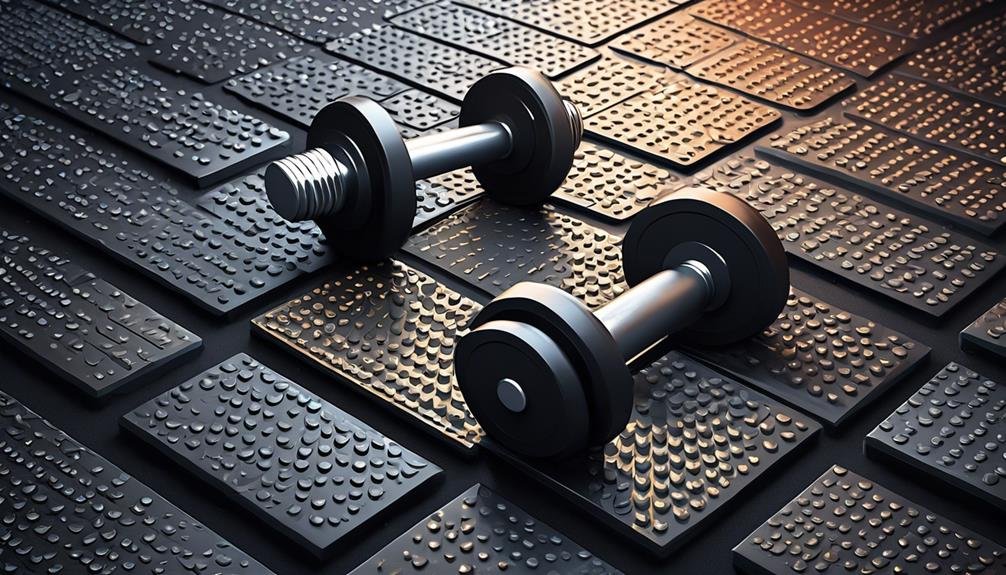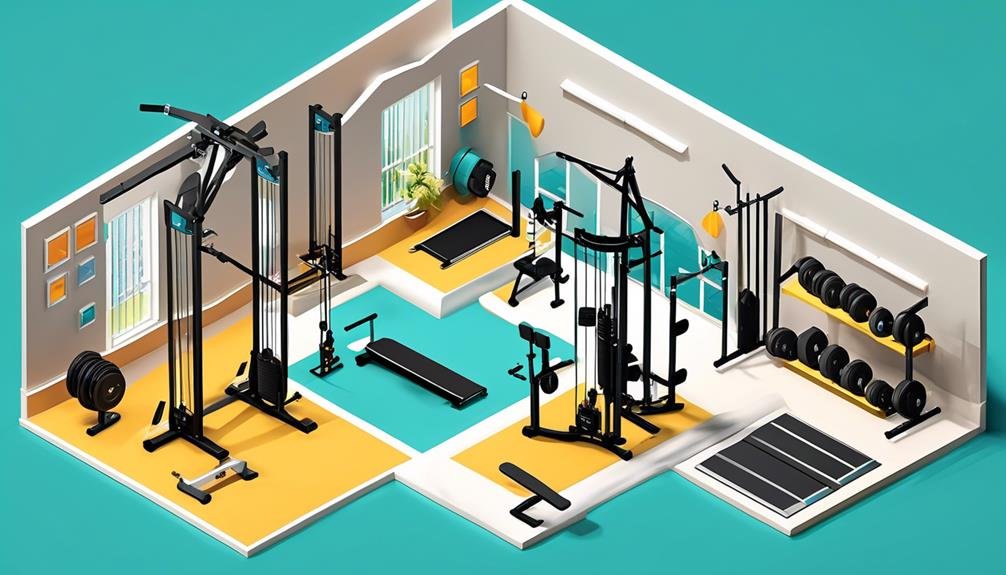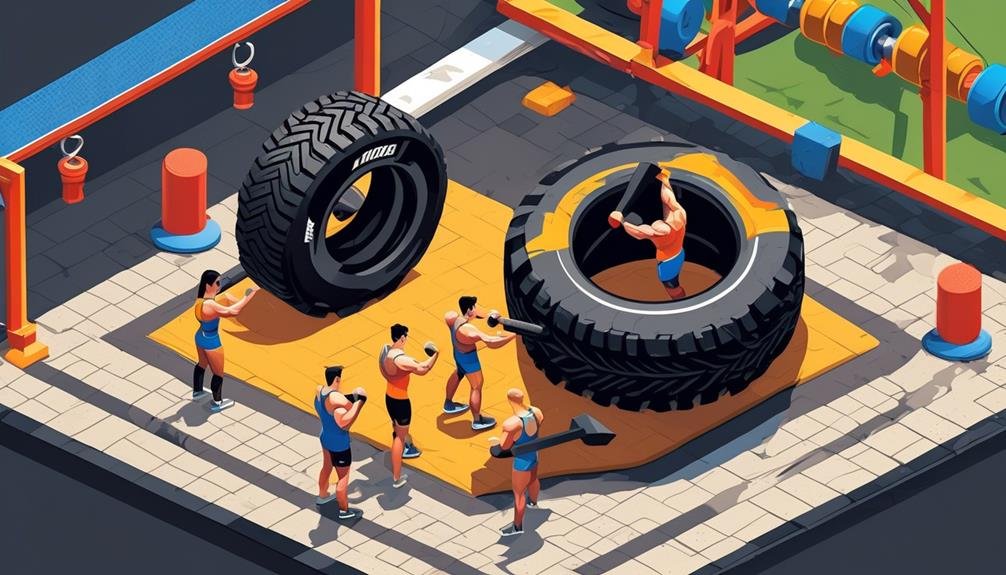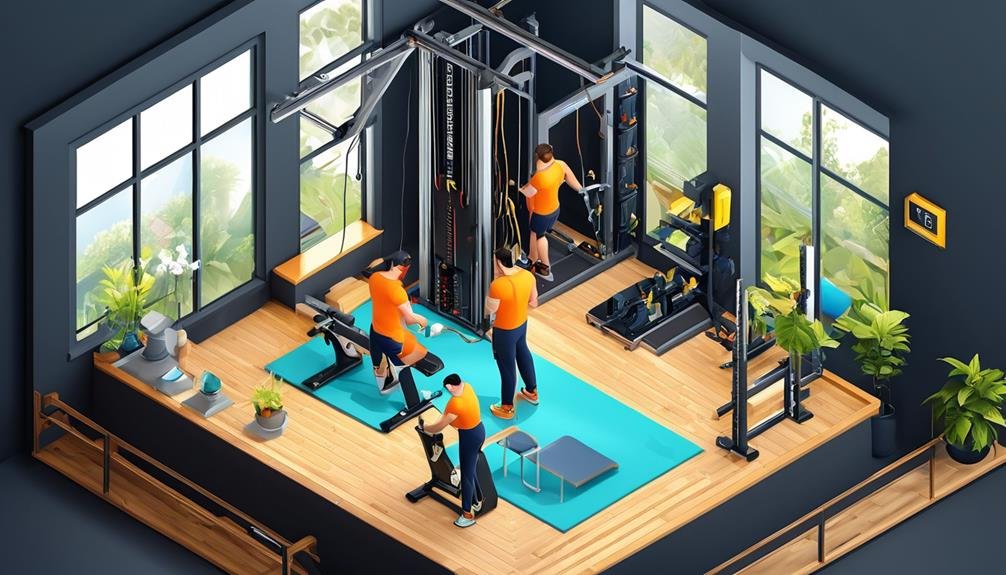Disclaimer: This content is for informational purposes only and does not replace professional medical advice, diagnosis, or treatment. Always consult a qualified healthcare provider before beginning any new exercise program.
Protecting your floors under free weights is like shielding a fragile flower from a storm. It requires careful consideration and proactive measures to ensure that your floors remain unscathed. But fret not, for there are solutions to this quandary.
In this discussion, we will explore various options, from the right flooring materials to protective mats and cleaning tips, that will help you keep your floors intact even in the face of heavy weights.
So, buckle up and get ready to discover the secrets of floor protection in the realm of free weights.
Key Takeaways
- Rubber flooring and mats are ideal for protecting floors under free weights due to their durability and shock absorption.
- Interlocking foam tiles provide cushioning and reduce noise, but may require more frequent replacement compared to rubber flooring.
- Protective mats should be thick enough to absorb dropped weights and have an anti-slip surface to prevent accidents.
- Regular maintenance and cleaning, including sweeping or vacuuming and immediate cleanup of spills, are important to prevent damage to the floors.
Proper Flooring Options
When selecting flooring options to protect your floors under free weights, it's crucial to choose materials that can withstand the heavy impact and prevent damage. The ideal flooring for this purpose is rubber.
Rubber flooring is known for its durability and shock-absorbing properties, making it an excellent choice for protecting your floors from the heavy impact of free weights. Rubber flooring is made from recycled rubber, which makes it both environmentally friendly and long-lasting.
When it comes to rubber flooring, there are two main types to consider: rubber tiles and rubber rolls.
Rubber tiles are individual tiles that can be easily installed and replaced if needed. They provide great traction and are resistant to both impact and moisture.
Rubber rolls, on the other hand, are large sheets of rubber that can be rolled out and cut to fit your specific space. They provide a seamless, smooth surface that's easy to clean and maintain.
In addition to rubber flooring, another option to consider is interlocking foam tiles. These tiles are made from high-density foam and are designed to absorb impact and reduce noise. They're lightweight, easy to install, and offer excellent shock absorption properties. However, it's important to note that foam tiles may not be as durable as rubber flooring and may need to be replaced more frequently.
Use Protective Mats
Consider using protective mats to further safeguard your floors under free weights.
Protective mats are an excellent solution to minimize damage and prevent scratches or dents caused by heavyweights. These mats are specifically designed to withstand the impact and pressure generated during weightlifting exercises.
When selecting protective mats, it's crucial to choose ones that are made from durable and high-quality materials, such as rubber or foam.
Rubber mats, in particular, offer exceptional shock absorption and can effectively reduce noise levels in your workout space. Foam mats, on the other hand, provide a cushioning effect that helps protect your floors from potential damage.
To ensure maximum protection, it's important to choose mats that are thick enough to absorb the impact of dropped weights. Mats with a thickness of at least ¾ inch are generally recommended for heavy lifting. Additionally, opt for mats that have an anti-slip surface to prevent accidents caused by slipping or tripping.
When placing the mats, make sure to cover the entire workout area, including the space around the weight rack. This will prevent any accidental drops from damaging the floor. It's also advisable to use interlocking mats that can be easily assembled and disassembled, allowing for convenient cleaning and maintenance.
Consider Rubber Flooring Tiles
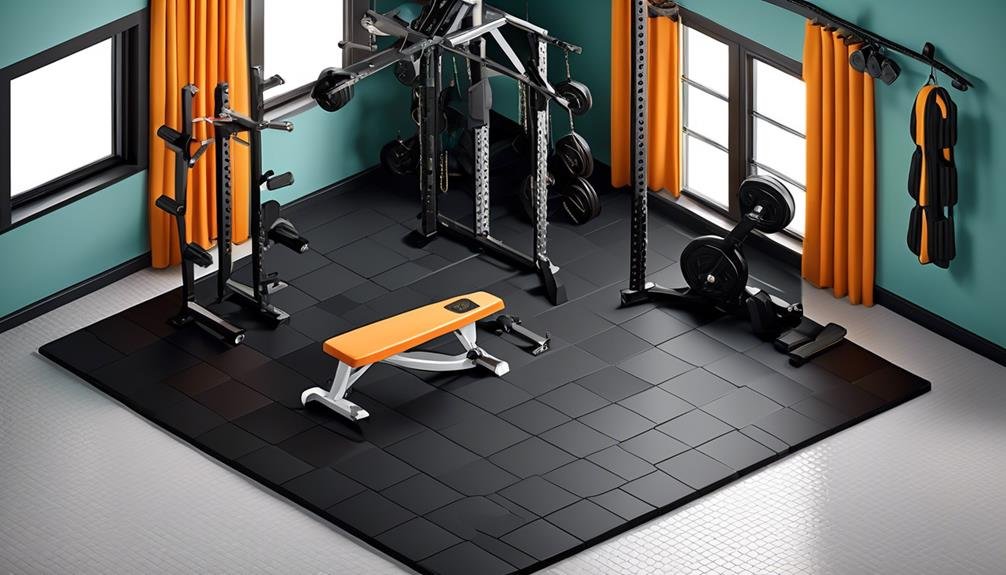
To further enhance the protection of your floors under free weights, explore the option of utilizing rubber flooring tiles. Rubber flooring tiles are an excellent choice for creating a safe and durable surface that can withstand the heavy impact of free weights. Here are three reasons why rubber flooring tiles are a smart investment for your gym or workout space:
- Superior Shock Absorption: Rubber flooring tiles have exceptional shock absorption properties, which means they can effectively absorb the impact of dropping heavy weights. This not only protects your floors from damage but also reduces the noise and vibrations that can disturb others in the vicinity.
- Slip-Resistant Surface: Safety should be a top priority, especially when working with free weights. Rubber flooring tiles offer a slip-resistant surface, ensuring that you maintain a stable footing even when your hands are sweaty or you're pushing your limits during a workout.
- Easy to Clean and Maintain: Rubber flooring tiles are incredibly easy to clean and maintain. They're resistant to stains, spills, and odors, making them an ideal choice for high-traffic areas. With just a simple mop or damp cloth, you can keep your gym floor looking clean and presentable at all times.
Install Drop Pads or Platforms
For enhanced safety and protection of your floors under free weights, the installation of drop pads or platforms is recommended. Drop pads or platforms are specially designed to absorb the impact and noise generated by dropping heavy weights. They provide a cushioned surface that minimizes the risk of damage to your floors and reduces noise levels in your gym or workout area.
When choosing drop pads or platforms, it is important to consider the material, thickness, and dimensions. Here is a comparison table to help you make an informed decision:
| Drop Pads | Platforms | |
|---|---|---|
| Material | High-density foam or rubber | Plywood with rubber or vinyl covering |
| Thickness | Typically 2-4 inches | Typically 1-2 inches |
| Dimensions | Various sizes available | Customizable sizes |
Drop pads made of high-density foam or rubber are lightweight and portable, making them easy to move and store. They provide excellent shock absorption and are suitable for both home and commercial use. Platforms, on the other hand, are more permanent solutions and offer a stable base for heavy lifting. They are typically built using plywood with a rubber or vinyl covering, providing durability and stability.
Maintenance and Cleaning Tips

To effectively maintain and clean your drop pads or platforms and ensure their longevity and performance, follow these expert tips:
- Regular Cleaning: Regularly sweep or vacuum the floor to remove any dirt, dust, or debris. This will prevent these particles from scratching or damaging the surface of your drop pads or platforms.
- Spot Cleaning: Immediately clean up any spills or stains that occur during your weightlifting sessions. Use a mild detergent or cleaning solution and a soft cloth or mop to gently scrub the affected area. Avoid using harsh chemicals or abrasive materials that could cause discoloration or damage.
- Deep Cleaning: Periodically, deep clean your drop pads or platforms to remove any built-up grime or residue. Use a gentle cleaning solution and a soft brush or mop to scrub the entire surface thoroughly. Rinse with clean water and allow it to dry completely before using again.
Frequently Asked Questions
Are There Any Alternative Flooring Options for Protecting Floors Under Free Weights Besides the Ones Mentioned in the Article?
There are alternative flooring options for protecting floors under free weights besides the ones mentioned. Consider using rubber mats, interlocking tiles, or heavy-duty vinyl flooring. These options provide added durability and protection against impact and noise.
Can I Use Regular Exercise Mats Instead of Protective Mats?
Regular exercise mats may not provide sufficient protection for your floors under free weights. Protective mats are specifically designed to absorb impact and prevent damage. It is recommended to use these mats for optimal floor protection.
Are Rubber Flooring Tiles Suitable for All Types of Free Weights, Including Heavy Ones?
Rubber flooring tiles are suitable for all types of free weights, including heavy ones. They provide excellent protection for your floors by absorbing impact and reducing noise. Make sure to choose tiles with a high weight capacity for maximum durability.
How Do Drop Pads or Platforms Contribute to Protecting the Floor Under Free Weights?
Drop pads or platforms contribute to protecting the floor under free weights by absorbing the impact and reducing the noise and vibrations caused by dropping weights. They provide a cushioning effect, preventing damage to the floor and ensuring its long-term durability.
Are There Any Specific Cleaning Products or Techniques Recommended for Maintaining the Protective Flooring?
To maintain protective flooring under free weights, it's important to use specific cleaning products and techniques. Regularly clean the floor using a non-abrasive cleaner and a soft mop or cloth. Avoid using harsh chemicals that can damage the flooring.
Conclusion
In conclusion, ensuring the protection of floors under free weights is crucial to maintain their longevity and prevent damage. By opting for proper flooring options such as rubber flooring tiles or protective mats, installing drop pads or platforms, and following maintenance and cleaning tips, you can effectively safeguard your floors.
Remember to regularly inspect and maintain the flooring to address any potential issues promptly. Taking these proactive measures will help preserve the integrity of your floors and provide a safe environment for your workouts.
